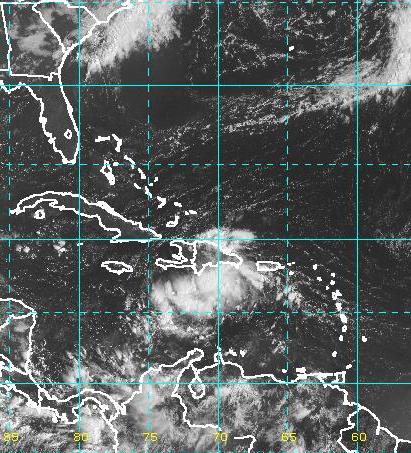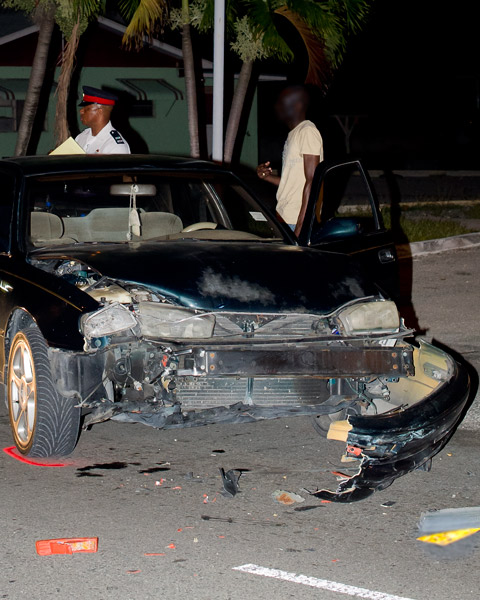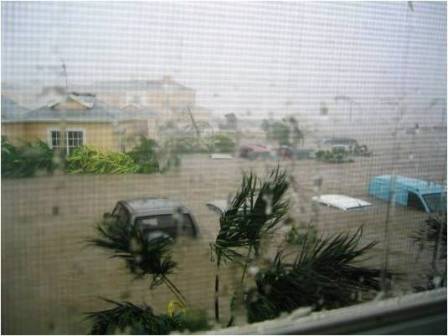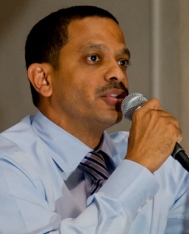Archive for September 11th, 2010

Season churns up more turbulent weather
 (CNS): As Igor strengthened into a category four hurricane on Sunday afternoon an area of showers and thunderstorms in the Caribbean remained less organised. However, forecasters from the NHC say it could still turn into a cyclone over the next few days. Regardless of development it is expected to bring some bad weather to the Cayman Islands on Monday or Tuesday. This broad area of low pressure located over Hispaniola has a fifty percent chance of developing over the next 48 hours the NHC said as environmental conditions appear favourable. Across the other side of the Atlantic TD12 also sprang to life as the season, true to predictions, continues to churn up turbulent weather.
(CNS): As Igor strengthened into a category four hurricane on Sunday afternoon an area of showers and thunderstorms in the Caribbean remained less organised. However, forecasters from the NHC say it could still turn into a cyclone over the next few days. Regardless of development it is expected to bring some bad weather to the Cayman Islands on Monday or Tuesday. This broad area of low pressure located over Hispaniola has a fifty percent chance of developing over the next 48 hours the NHC said as environmental conditions appear favourable. Across the other side of the Atlantic TD12 also sprang to life as the season, true to predictions, continues to churn up turbulent weather.

JA closes one programme opens doors for next
(CNS): As this year’s Junior Achievement programme draws to a close, eight students went on an all expenses paid trip to the Junior Achievement Canadian International Youth Leadership Conference, Next Generation Leaders. The business conference gives many high-potential young people across the world an opportunity to network and share experiences. As one group ends its time with the JA programme taking valuable experiences away JA organisers are now inviting applications for its next session when awhole new group of students try their hand in the business world.

YUDP lobbies government for insurance watchdog
 (CNS): As a result of hardship suffered by a number of young people being hit by drivers who are either uninsured or drunk, making their policies void, the YUDP is lobbying government to do something about the law and regulation of the industry. The young politicians said that some of the difficulties experienced are largely due to the fact the there is no government body responsible for monitoring and regulating the policies for general and motor insurance. Although insurance providers are licensed by Cayman Islands Monetary Authority (CIMA), the YUDP has called for an industry “watchdog” to monitor the sector and deal with complaints. (Photo Dennie WarrenJr)
(CNS): As a result of hardship suffered by a number of young people being hit by drivers who are either uninsured or drunk, making their policies void, the YUDP is lobbying government to do something about the law and regulation of the industry. The young politicians said that some of the difficulties experienced are largely due to the fact the there is no government body responsible for monitoring and regulating the policies for general and motor insurance. Although insurance providers are licensed by Cayman Islands Monetary Authority (CIMA), the YUDP has called for an industry “watchdog” to monitor the sector and deal with complaints. (Photo Dennie WarrenJr)

Training starts for census workers
(CNS): With the country’s 2010 census only a month away the Economics and Statistics Office has begun a six day workshop to train twenty people who in turn will train almost 400 census field supervisors and enumerators. The training is a key step in building a properly trained workforce for Census 2010, Cayman’s population and housing count that kicks off on Census Day (10 October or 10-10-10) and continues through November. The census will capture data on subjects such as health insurance, housing and mortality to help create a more comprehensive database to better aid planning for the Islands’ future.
Restaurants offer solutions for diversity challenges
(CNS): In the latest edition of Flicker, the Department of Environment’s monthly magazine bulletin, the Ecology Unit looks at lionfish suppers and Casuarina roasts and the restaurants that are addressing some of the challenges facing threats to species diversity. While Mezza is helping out with the islands’ invasive lionfish problem by serving up the reportedly tasty fish on its menu, Michaels, a new restaurant in Camana Bay, is hoping to offer a solution to the choking effects of the Casuarinas. The restaurant is offering people the opportunity to make some money by selling their unwanted trees.
Although Casuarina trees have been in Cayman a long time they are not native and they are something of a mixed blessing. While providing welcome shade on the beach, the shed pines actively smother all other species.

Butterfield sells business back to Bentley Reid Group
(CNS): Butterfield has sold its trust, wealth management and advisory businesses in Hong Kong and its trust operation in Malta back to the original founder the bank said this week. In October 2007, Butterfield acquired the entire share capital of the Bentley Reid Group, a privately held international wealth management company with offices in Hong Kong, Malta and the United Kingdom. Nic Bentley, Deputy Chairman, Butterfield Private Office (HK) Limited founder and former Chairman of the Bentley Reid Group, will reacquire the Malta and Hong Kong businesses.

Cayman marks sixth anniversary of Hurricane Ivan
 (HMCI): As Igor rumbles across the Atlantic from its birth place south of the Cape Verde Islands, Cayman is also remembering another storm that came from the same place. It is six years this weekend since the infamous Hurricane Ivan hit these shores and it remains one of the most powerful hurricanes to hit the Caribbean in recorded history. On September 2 Ivan developed into a tropical depression, it became a tropical storm on the following day and reached hurricane status on 5 September. Eventually it made its way to the Cayman Islands when on Sunday 12 September the eye passed 21 miles South West of Grand Cayman with winds of 150 mph and gusts of 220 mph.
(HMCI): As Igor rumbles across the Atlantic from its birth place south of the Cape Verde Islands, Cayman is also remembering another storm that came from the same place. It is six years this weekend since the infamous Hurricane Ivan hit these shores and it remains one of the most powerful hurricanes to hit the Caribbean in recorded history. On September 2 Ivan developed into a tropical depression, it became a tropical storm on the following day and reached hurricane status on 5 September. Eventually it made its way to the Cayman Islands when on Sunday 12 September the eye passed 21 miles South West of Grand Cayman with winds of 150 mph and gusts of 220 mph.

 The total economic impact to the Cayman Islands was estimated by the United Nations ECLAC team to be 3.4 billion (183 % of GDP). Approximately 83% or 13,535 units of the total housing stock in the Grand Cayman suffered some degree of damage. Dwellings which were situated on the sea shore, in low lying, or swampyareas suffered the most severe damage. Older and less well constructed housing was also severely affected.
The total economic impact to the Cayman Islands was estimated by the United Nations ECLAC team to be 3.4 billion (183 % of GDP). Approximately 83% or 13,535 units of the total housing stock in the Grand Cayman suffered some degree of damage. Dwellings which were situated on the sea shore, in low lying, or swampyareas suffered the most severe damage. Older and less well constructed housing was also severely affected.
University offers opportunity to appreciate local dance
 (CNS): The University College of the Cayman Islands (UCCI) is offering a new course on Caribbean and local dance forms exploring the role of traditional Caribbean its meaning, purpose and relationship to other art forms in contemporary Caymanian society. The course is an intentional departure from the traditional academic norm at UCCI as UCCI President Roy Bodden said arts have much to offer in terms of personal growth and development. Facilitated by Adjunct Professor Dr. Monika Lawrence, from the University of Technology in Jamaica, as well as physically experiencing selected dance styles, students can study dance theory and evaluate Caribbean dance history within the context of cultural identity and development.
(CNS): The University College of the Cayman Islands (UCCI) is offering a new course on Caribbean and local dance forms exploring the role of traditional Caribbean its meaning, purpose and relationship to other art forms in contemporary Caymanian society. The course is an intentional departure from the traditional academic norm at UCCI as UCCI President Roy Bodden said arts have much to offer in terms of personal growth and development. Facilitated by Adjunct Professor Dr. Monika Lawrence, from the University of Technology in Jamaica, as well as physically experiencing selected dance styles, students can study dance theory and evaluate Caribbean dance history within the context of cultural identity and development.

Minister calls on community to tackle diseases
 (CNS): On Caribbean Wellness Day the health minister has said that despite medical advantages in our region, it faces the highest rates of chronic disease in the Americas. Mark Scotland said that while we have more knowledge and better testing, chronic illness figures are increasing, especially in childhood obesity and diabetes. He noted, however that these conditions are preventable if people make conscious decisions to live better. He called on parents to make better choices about health and lead by example with how they spent leisure time and the decisions they made in the grocery store.
(CNS): On Caribbean Wellness Day the health minister has said that despite medical advantages in our region, it faces the highest rates of chronic disease in the Americas. Mark Scotland said that while we have more knowledge and better testing, chronic illness figures are increasing, especially in childhood obesity and diabetes. He noted, however that these conditions are preventable if people make conscious decisions to live better. He called on parents to make better choices about health and lead by example with how they spent leisure time and the decisions they made in the grocery store.
Mark Scotland’s message:
Caribbean Wellness Day was first celebrated three years ago to promote healthy living and encourage people to develop good health practices. With the theme ‘love that body’, this day places emphasis on national and community level activities that aim to improve the people’s health.
And so, as we celebrate this year’s Caribbean Wellness Day, it is fitting – and imperative – that we pay attention to the pending health crisis that faces our region. Ailments such as hypertension, ischemic heart disease and stroke, cancer, chronic respiratory diseases and diabetes are the leading causes of premature death in this part of the world. A staggering two of three deaths occurring in persons younger than 70 years results from a chronic disease.
Ironically, even as this region has made great strides in securing better medical care for its citizens, we still find ourselves facing the highest rates of chronic disease in the Americas. We have more knowledge and better testing, but we are still witnessing rapidly increasing chronic illness figures, especially in childhood obesity and diabetes.
Apart from negatively affecting the quality of life of sufferers and their families, chronic diseases impose a huge financial burden on individuals and governments alike. Indeed, according to a CARICOM estimate, the societal costs of diabetes alone in Latin America and the Caribbean amounted to some $53 billion in 2000.
But there is good news: While it is escalating, this chronic disease epidemic is in large part preventable, particularly if we all make conscious decisions to live better.
In this regard, we are fortunate here in Cayman to see a growing partnership between the private and public sector in securing the long-term health of our population. For instance the free health screenings (for diabetes, hypertension and cholesterol) on offer this month, compliments of the Heart Health Centre and the Cayman Islands Health Services Authority.
The Public Health Department will also continue this month with its health awareness campaign, presenting school children with fruit and water at school.
Of course governments should provide good healthcare and support, but the sobering truth is that we are the only ones who can thwart this potentially crippling health emergency. Truly then, the difference does start at home. It begins with the example we set as parents and it flows from the simple choices we make in the supermarket and in pursuing our recreational activities.
My hope therefore is that this Caribbean Wellness Day will inspire you to ‘love that body’ and make at least one positive change in your life. Without question, living healthily is one of the best investments you can possibly make for you and your family. So why wait?

Love that body
The observance of Caribbean Wellness Day (CWD) has been one of the commitments made by the Caribbean Community (CARICOM) heads of government in the fight against chronic diseases. Initiated in 2008, this is a collective regional recognition of the physical, economic and social burdens caused by lifestyle-related diseases such as diabetes, hypertension, stroke, heart disease, obesity and some types of cancer.
The corresponding theme “Love that Body” aims to heighten awareness of health and well being, encourage persons to engage in regular physical activity and choose healthy lifestyles.